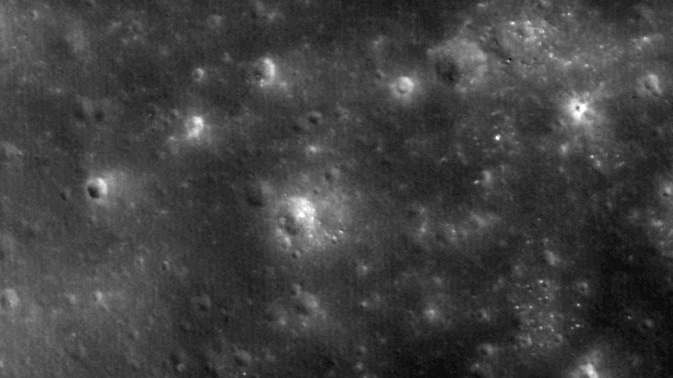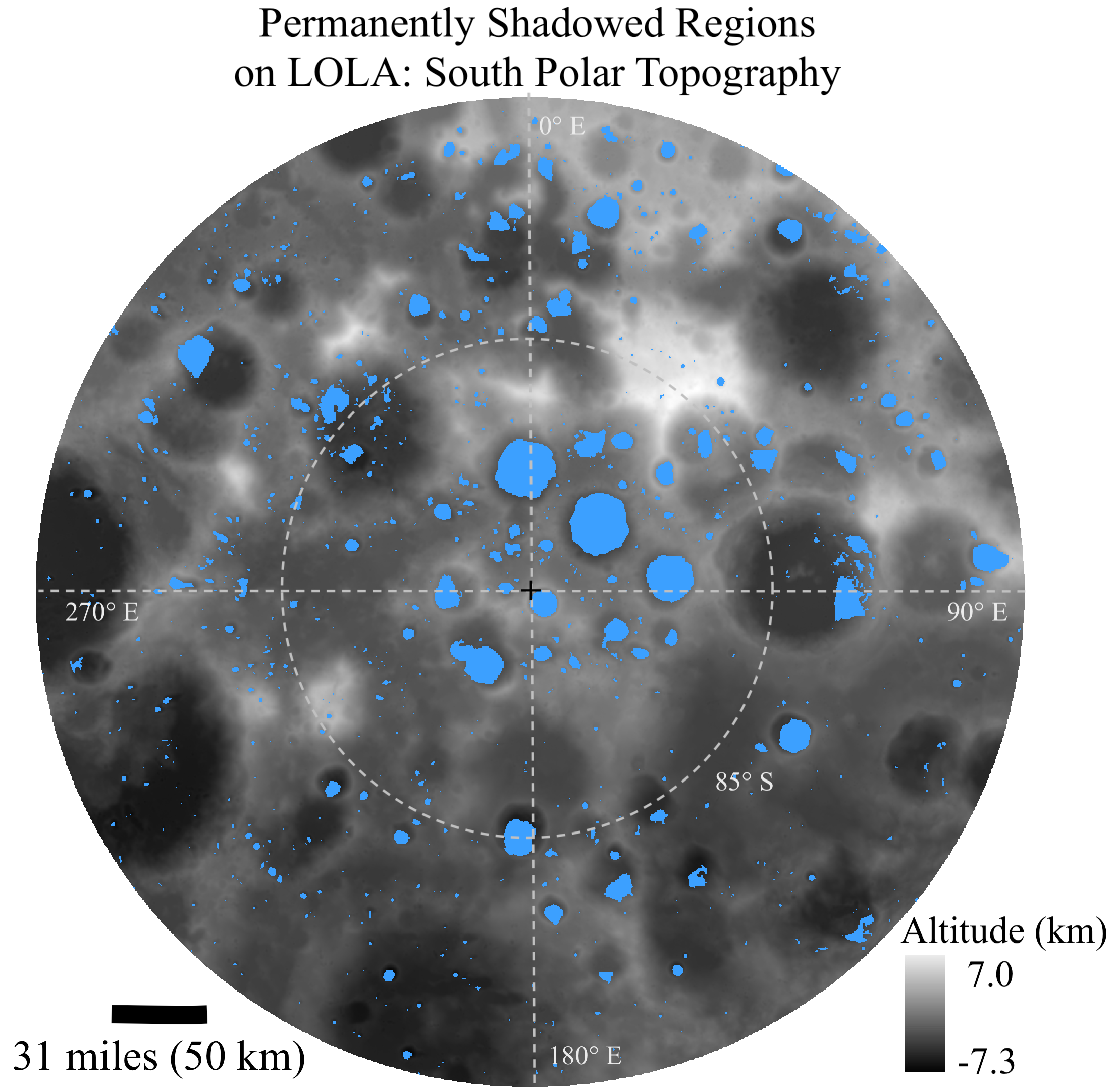5 min read
NASA’s LRO: Lunar Ice Deposits are Widespread Deposits of ice in lunar dust and rock (regolith) are more extensive than previously thought, according to a new analysis of data from NASA’s LRO (Lunar Reconnaissance Orbiter) mission. Ice would be a valuable resource for future lunar expeditions. Water could be used for radiation protection and supporting human explorers, or broken into its hydrogen and oxygen components to make rocket fuel, energy, and breathable air.
Prior studies found signs of ice in the larger permanently shadowed regions (PSRs) near the lunar South Pole, including areas within Cabeus, Haworth, Shoemaker and Faustini craters. In the new work, “We find that there is widespread evidence of water ice within PSRs outside the South Pole, towards at least 77 degrees south latitude,” said Dr. Timothy P. McClanahan of NASA’s Goddard Space Flight Center in Greenbelt, Maryland, and lead author of a paper on this research published October 2 in the Planetary Science Journal.
The study further aids lunar mission planners by providing maps and identifying the surface characteristics that show where ice is likely and less likely to be found, with evidence for why that should be. “Our model and analysis show that greatest ice concentrations are expected to occur near the PSRs’ coldest locations below 75 Kelvin (-198°C or -325°F) and near the base of the PSRs’ poleward-facing slopes,” said McClanahan.
 This illustration shows the distribution of permanently shadowed regions (in blue) on the Moon poleward of 80 degrees South latitude. They are superimposed on a digital elevation map of the lunar surface (grey) from the Lunar Orbiter Laser Altimeter instrument on board NASA’s Lunar Reconnaissance Orbiter spacecraft. NASA/GSFC/Timothy P. McClanahan “We can’t accurately determine the volume of the PSRs’ ice deposits or identify if they might be buried under a dry layer of regolith. However, we expect that for each surface 1.2 square yards (square meter) residing over these deposits there should be at least about five more quarts (five more liters) of ice within the surface top 3.3 feet (meter), as compared to their surrounding areas,” said McClanahan. The study also mapped where fewer, smaller, or lower-concentration ice deposits would be expected, occurring primarily towards warmer, periodically illuminated areas.
This illustration shows the distribution of permanently shadowed regions (in blue) on the Moon poleward of 80 degrees South latitude. They are superimposed on a digital elevation map of the lunar surface (grey) from the Lunar Orbiter Laser Altimeter instrument on board NASA’s Lunar Reconnaissance Orbiter spacecraft. NASA/GSFC/Timothy P. McClanahan “We can’t accurately determine the volume of the PSRs’ ice deposits or identify if they might be buried under a dry layer of regolith. However, we expect that for each surface 1.2 square yards (square meter) residing over these deposits there should be at least about five more quarts (five more liters) of ice within the surface top 3.3 feet (meter), as compared to their surrounding areas,” said McClanahan. The study also mapped where fewer, smaller, or lower-concentration ice deposits would be expected, occurring primarily towards warmer, periodically illuminated areas.
Ice could become implanted in lunar regolith through comet and meteor impacts, released as vapor (gas) from the lunar interior, or be formed by chemical reactions between hydrogen in the solar wind and oxygen in the regolith. PSRs typically occur in topographic depressions near the lunar poles. Because of the low Sun angle, these areas haven’t seen sunlight for up to billions of years, so are perpetually in extreme cold. Ice molecules are thought to be repeatedly dislodged from the regolith by meteorites, space radiation, or sunlight and travel across the lunar surface until they land in a PSR where they are entrapped by extreme cold. The PSR’s continuously cold surfaces can preserve ice molecules near the surface for perhaps billions of years, where they may accumulate into a deposit that is rich enough to mine. Ice is thought to be quickly lost on surfaces that are exposed to direct sunlight, which precludes their accumulations.
The team used LRO’s Lunar Exploration Neutron Detector (LEND) instrument to detect signs of ice deposits by measuring moderate-energy, “epithermal” neutrons. Specifically, the team used LEND’s Collimated Sensor for Epithermal Neutrons (CSETN) that has a fixed 18.6-mile (30-kilometer) diameter field-of-view. Neutrons are created by high-energy galactic cosmic rays that come from powerful deep-space events such as exploding stars, that impact the lunar surface, break up regolith atoms, and scatter subatomic particles called neutrons. The neutrons, which can originate from up to about a 3.3-foot (meter’s) depth, ping-pong their way through the regolith, running into other atoms. Some get directed into space, where they can be detected by LEND. Since hydrogen is about the same mass as a neutron, a collision with hydrogen causes the neutron to lose relatively more energy than a collision with most common regolith elements. So, where hydrogen is present in regolith, its concentration creates a corresponding reduction in the observed number of moderate-energy neutrons.
“We hypothesized that if all PSRs have the same hydrogen concentration, then CSETN should proportionally detect their hydrogen concentrations as a function of their areas. So, more hydrogen should be observed towards the larger-area PSRs,” said McClanahan.
The model was developed from a theoretical study that demonstrated how similarly hydrogen-enhanced PSRs would be detected by CSETNs fixed-area field-of-view. The correlation was demonstrated using the neutron emissions from 502 PSRs with areas ranging from 1.5 square miles (4 km2) to 417 square miles (1079 km2) that contrasted against their surrounding less hydrogen-enhanced areas. The correlation was expectedly weak for the small PSRs but increased towards the larger-area PSRs.
The research was sponsored by the LRO project science team, NASA’s Goddard Space Flight Center’s Artificial Intelligence Working Group, and NASA grant award number 80GSFC21M0002. The study was conducted using NASA’s LRO Diviner radiometer and Lunar Orbiter Laser Altimeter instruments. The LEND instrument was developed by the Russian Space Agency, Roscosmos by its Space Research Institute (IKI). LEND was integrated to the LRO spacecraft at the NASA Goddard Space Flight Center. LRO is managed by NASA’s Goddard Space Flight Center in Greenbelt, Maryland, for the Science Mission Directorate at NASA Headquarters in Washington.
Details Last Updated Oct 03, 2024 Editor wasteigerwald Contact wasteigerwald william.a.steigerwald@nasa.gov Location Goddard Space Flight Center Related Terms Earth’s Moon Goddard Space Flight Center Lunar Reconnaissance Orbiter (LRO) The Solar System


 6 min read NASA’s LRO Discovers Lunar Hydrogen More Abundant on Moon’s Pole-Facing Slopes Space travel is difficult and expensive – it would cost thousands of dollars to launch…
6 min read NASA’s LRO Discovers Lunar Hydrogen More Abundant on Moon’s Pole-Facing Slopes Space travel is difficult and expensive – it would cost thousands of dollars to launch…
 4 min read NASA’s LRO Finds Lunar Pits Harbor Comfortable Temperatures NASA-funded scientists have discovered shaded locations within pits on the Moon that always hover around…
4 min read NASA’s LRO Finds Lunar Pits Harbor Comfortable Temperatures NASA-funded scientists have discovered shaded locations within pits on the Moon that always hover around…
 4 min read NASA’s LRO Spacecraft Captures Images of LADEE’s Impact Crater NASA’S Lunar Reconnaissance Orbiter (LRO) spacecraft has spied a new crater on the lunar surface;…
4 min read NASA’s LRO Spacecraft Captures Images of LADEE’s Impact Crater NASA’S Lunar Reconnaissance Orbiter (LRO) spacecraft has spied a new crater on the lunar surface;…
